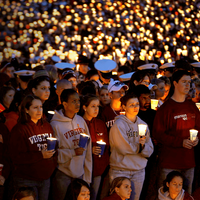Yesterday marked the ten year anniversary of the tragedy at Virginia Tech. Over the course of these last few weeks our hearts were heavy as the anniversary crept closer and closer. Today, and all days going forward, we remember those lost and the families impacted.
Though a terrible tragedy, what happened at Virginia Tech was fuel for hundreds of higher education institutions (and even non-higher education institutions) to improve how they protect and notify their people.
“April 16, 2007, was the day that the world of college and university campus safety changed forever,” said S. Daniel Carter when speaking with the Roanoke Times for their piece, “Virginia Tech shootings watershed moment for advancing public safety on college campuses”.
We could not agree more. Critical and emergency notifications were never viewed the same way again.
The Clery Act became law in 1990, making it mandatory for colleges and universities to publish their crime statistics and to send a warning for specific safety threats to students and the campus population. But after the Virginia Tech shootings, The Clery Act was actually amended - pushed by the families of the victims - to mandate schools to send emergency notifications for a broader range of incidents and in a more timely fashion. Colleges and universities all over the nation now understood the value of implementing and utilizing an emergency notification system in light of what happened at Virginia Tech.
“Universities/higher education were the early adopters. Prior to Virginia Tech there were probably 30 schools or campuses that had this type of technology implemented. After Virginia Tech there were probably 30 a day”, says Omnilert’s Vice President Frank McCathran while on the Kojo Nnamdi show segment, “How The Virginia Tech Tragedy Changed Campus Safety Culture” last week.
McCathran continued discussion with Kojo Nnamdi and Campus Security Consultant S. Daniel Carter on the show about the November 2016 Ohio State University car and knife attack. “Although most would say the response was a success, the OSU safety team uncovered additional lessons”, McCathran states. An emergency notification system was utilized during the event, but OSU’s committee found they relied too much on texting and didn't embrace multimodality in order to get the alerts to people no matter where they are, or what they are doing. They also found they weren’t engaging their external first responders enough. It is important to utilize technology to not only notify your community, but to mobilize external responders, and collaborate further with your entire team.
Obtaining a way to communicate with the student population and campus community by adopting an emergency notification system was the first revelation for campuses. Soon after came the best practice to become Omnimodal - and utilize as many communication channels as possible - as OSU found they should be doing.
In the beginning, sending a text notification was popular and understood by student populations, but administrators were still catching on. During his segment, Kojo Nnamdi put it perfectly: “Texting was like the breakfast cereal, Trix, just for kids, but now texting is a pretty standard mode of communication.” It has really become just a baseline or the bare minimum.
On becoming Omnimodal, Campus Security Consultant S. Daniel Carter continues, “…schools were required to get a timely warning out as soon as the pertinent information was available. And the Department of Education had long said that was to be determined on a case by case basis, and that really evolved as the technology evolved. Originally when the law was first passed in 1990, fliers were the most common way to get the word out and there really were not faster channels available. But as technology advanced, faster channels became more and more available, and now you have a multimodal or multi-channel approach that many institutions are taking that not only rely on text alerts but apps, PA systems, message boards, closed circuit television, etc.”
“It’s critical to get information to people in whatever means they consume it,” said Omnilert co-founder and CEO, Ara Bagdasarian, in the Roanoke Times piece. He continues, “It’s also about redundancy. So what if you get a text, but your phone is on mute? You need to use as many channels to notify people as possible.”
Thankfully, over the time that has passed, emergency notification systems on college campuses have become somewhat “the norm”, and something college applicants look for and expect. “Students expect to be immediately notified when there’s a threat or potential threat to their safety, and there’s no turning back from that. That has been a cultural shift.” Carter states.
As we pause to remember the victims and families impacted by the events on April 16, 2007 at Virginia Tech, it is almost impossible not to also ask ourselves, “what could have happened differently?” or “what could have been done better?”. It is thoughts like those that demand safety teams at institutions improve the way they are doing things, technology solutions to develop more effective safety and communication tools, and for them both to work together to help decrease the chances of it ever happening again.
If you strive to improve emergency notifications and response at your organization but need assistance or recommendations, we'd be happy to connect you with an emergency notifications expert on the Omnilert team.
If you have questions about The Clery Act or policies and procedures to help your organization improve compliance, reach out to Campus Security Consultant S. Daniel Carter.


